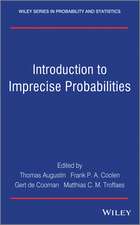COMPSTAT: Proceedings in Computational Statistics 14th Symposium held in Utrecht, The Netherlands, 2000
Editat de Jelke G. Bethlehem, Peter G.M. van der Heijdenen Limba Engleză Paperback – 4 aug 2000
Preț: 653.14 lei
Preț vechi: 768.40 lei
-15% Nou
Puncte Express: 980
Preț estimativ în valută:
125.02€ • 135.84$ • 105.08£
125.02€ • 135.84$ • 105.08£
Carte tipărită la comandă
Livrare economică 21 aprilie-05 mai
Preluare comenzi: 021 569.72.76
Specificații
ISBN-13: 9783790813265
ISBN-10: 3790813265
Pagini: 556
Ilustrații: XII, 540 p. 1 illus.
Dimensiuni: 155 x 235 x 29 mm
Greutate: 0.77 kg
Ediția:Softcover reprint of the original 1st ed. 2000
Editura: Physica-Verlag HD
Colecția Physica
Locul publicării:Heidelberg, Germany
ISBN-10: 3790813265
Pagini: 556
Ilustrații: XII, 540 p. 1 illus.
Dimensiuni: 155 x 235 x 29 mm
Greutate: 0.77 kg
Ediția:Softcover reprint of the original 1st ed. 2000
Editura: Physica-Verlag HD
Colecția Physica
Locul publicării:Heidelberg, Germany
Public țintă
ResearchCuprins
Keynote papers.- The broad role of multiple imputation in statistical science.- Official Statistics: an estimation strategy for the IT-era.- Invited papers.- Bayesian model selection methods for nonnested models.- Spatio-temporal hierarchical modeling of an infectious disease from (simulated) count data.- GBMs: GLMs with bilinear terms.- Generalized calibration and application to weighting for non-response.- Methodological issues in data mining.- Practical data mining in a large utility company.- HGLMs for analysis of correlated non-normal data.- Bootstrapping impulse responses in VAR analyses.- An application of TRAMO-SEATS; model selection and out-of-sample performance. The Swiss CPI series.- Spreadsheets as tools for statistical computing and statistics education.- An algorithm for deepest multiple regression.- Non-proportional hazards models in survival analysis.- A spatio-temporal analysis of a field trial.- Contributed papers.- Principal component logistic regression.- Sieve bootstrap prediction intervals.- Clustering by maximizing a fuzzy classification maximum likelihood criterion.- Tree-based algorithms for missing data imputation.- MiPy: a system for generating multiple imputations.- A linear approximation to the wild bootstrap in specification testing.- The size of the largest nonidentifiable outlier as a performance criterion for multivariate outlier identification: the case of high-dimensional data.- The influence of data generation and imputation methods on the bias of factor analysis of rating scale data.- Model on a population and prediction on another one: a generalized discriminant rule.- Disclosure control on multi-way tables by means of the shuttle algorithm: extensions and experiments.- An MLE strategy for combining optimally pruned decision trees.-Semi-parametric models for data mining.- Preliminary estimation of ARFIMA models.- A collection of applets for visualizing statistical concepts.- Non-parametric regression and density estimation under control of modality.- Multivariate approaches for aggregate time series.- Some space-time models: an application to NO2 pollution in an urban area.- SLICE: generalised software for statistical data editing and imputation.- Improved PCB inspection: computational issues.- Optimization of the antithetic Gibbs sampler for Gaussian Markov random fields.- Computing zonoid trimmed regions of bivariate data sets.- Outlier resistant estimators for canonical correlation analysis.- Graphical and phase space models for univariate time series.- The use of the Tweedie distribution in statistical modelling.- Predictive dimension: an alternative defmition to embedding dimension.- Post-stratification to correct for nonresponse: classification of ZIP code areas.- Approximate Bayesian inference for simple mixtures.- Correlated INAR(1) process.- Confidence regions for stabilized multivariate tests.- Comparison of stationary time series using distribution-free methods.- Generation of Boolean classification rules.- A statistical package based on Pnuts.- Generalized regression trees.- Generalized linear mixed models: an improved estimating procedure.- The stochastic dimension in a dynamic GIS.- A robust version of principal factor analysis.- TESS: system for automatic seasonal adjustment and forecasting of time series.- The BADAME project.- Improving Statistics Canada’s cell suppression software (CONFID).- The multimedia project MM*STAT for teaching statistics.- Projection pursuit approach to robust canonical correlation analysis.- A fast algorithm for highly robust regression in datamining.- Optimal classification trees.- GAM spline algorithms: a direct comparison.- Markov Chain Monte Carlo methods for handling missing covariates in longitudinal mixed models.- Robust Bayesian classification.- Social science measurement by means of item response models.- Multivariate DLMs for forecasting financial time series, with application to the management of portfolios.- An algorithm for the multivariate Tukey median.- Analyzing and synthesizing information from a multiple-study database.- Bootstrapping neural discriminant model.- An improved algorithm for robust PCA.- Applying techniques of dynamic programming to sequential mastery testing.- The introduction of formal structure into the processing of statistical summary data.- Validation of association rules by interactive mosaic plots.- Optimality models for PRAM.- Dealing with real ordinal data: recent advances in analyzing tied, censored, and multivariate observations.- Testing for differences in location: a comparison of bootstrap methods in the small sample case.- Two principal points for location mixtures.- Vector splines and other vector smoothers.- Index of authors.- Index of keywords.
Textul de pe ultima copertă
This book contains the keynote, invited and full contributed papers presented at COMPSTAT 2000, held in Utrecht. The papers range over all aspects of the link between statistical theory and applied statistics, with special attention for developments in the area of official statistics. The papers have been thoroughly refereed.











